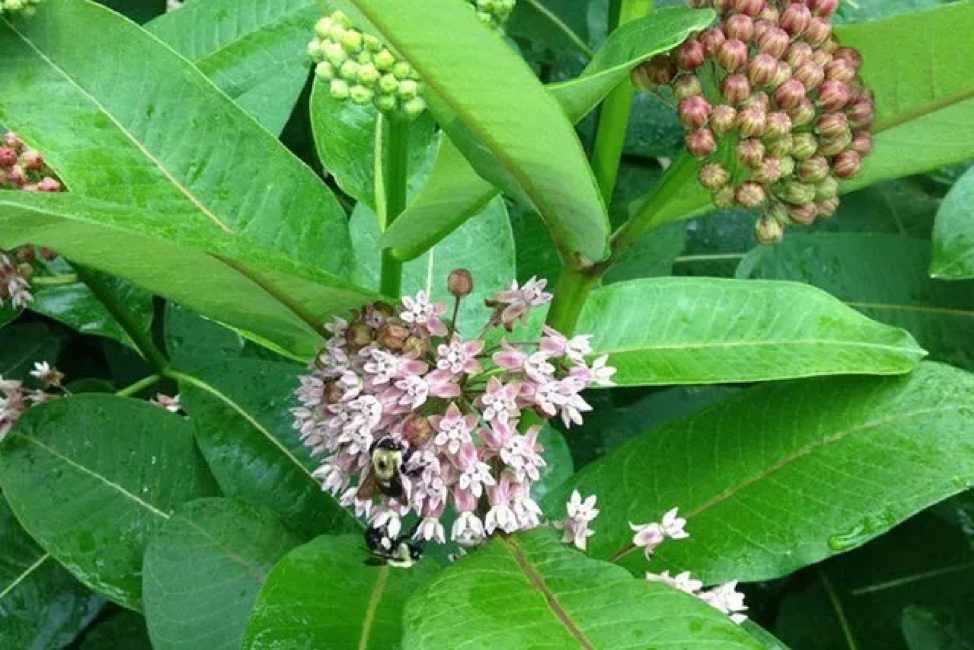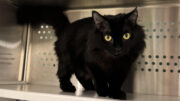Common milkweed, Asclepias syriaca, not only provides nectar for butterflies, bees, and other pollinators but is a larval host plant for butterflies and moths.

Description
General: Common milkweed is a deciduous, native, herbaceous perennial wildflower in the Apocynaceae (dogbane) family. It grows in average, well-drained soils in full sun but can tolerate poor or dry soils.
It propagates easily by seed or root cuttings and will naturalize in the garden, taking up quite a bit of space.
In summer, five-petaled flowers bloom with up to 100 flowers per cluster and one to three clusters per stem. Fragrant flowers in colors of green, pink, white, and purple or lavender will last from June through August.
Plants can grow 3 to 5 feet tall. Leaf arrangement is opposite and is oblong in shape with reddish veins.
Native Americans used the milkweed plant for fiber sources. Life jackets were made from the coma of the seeds during WWII. Today, coma is used for pillows and blankets.
Common milkweed can be used in naturalized areas, meadows, and butterfly, native, or pollinator gardens, but its wild and rangy form is not ideal for planting in borders.
The plant contains cardiac glycosides, allied to digitalins, used in treating some heart diseases. These glycosides, when absorbed by monarch butterfly larvae whose sole source of food is milkweed foliage, make the larvae and adult butterflies toxic to birds and other predators. The bark, flower, seed pods, leaves, roots, and stems are poisonous, which can also be a problem for cats, dogs, and horses.
Growing Conditions
Common milkweed is a deciduous, native, herbaceous perennial wildflower. It grows in average, well-drained soils in full sun but can tolerate poor or dry soils.
Propagation
It propagates easily by seed or root cuttings and will naturalize in the garden. Rhizomes can be cut and transplanted early in the spring.
Wildlife Value
Common milkweed not only provides nectar for butterflies, bees, and other pollinators but is a larval host plant for Monarch and Queen butterflies and Milkweed tussock moths. Adult Monarch butterflies feed on nectar from all species of milkweeds. Milkweed is also fed upon by the milkweed weevil and milkweed longhorn beetle.
Creating habitat is one of the most important actions you can take to help the monarch butterfly. From backyard gardens to sprawling grasslands scattered across the country, these areas provide a network of crucial habitat for monarchs. Fortunately, the habitats that monarchs use also provide substantial benefits to other wildlife species.
High-quality monarch habitat that includes a diverse assortment of native milkweeds and nectar plants can also support a wide range of wildlife. Because the habitat needs of pollinators overlap with those of other animals, pollinator conservation allows us to protect multiple species at once.
- Special Value to Native Bees (Recognized by pollination ecologists as attracting large numbers of native bees.)
- Special Value to Bumble Bees
- Special Value to Honey Bees
Supports Conservation Biological Control (A plant that attracts predatory or parasitoid insects that prey upon pest insects.)
Diseases and Pests
Several diseases and pests can affect milkweed. Some symptoms of diseased or unhealthy milkweed plants include unusual spots on the leaves, misshapen or asymmetrical leaves or pods, or plants that appear wilted or weakened. These things can be caused by a number of different fungi or bacteria, but it is usually a good first step to look for tiny insects on the undersides of the leaves that may be eating the plant (not aphids). If these tiny thrips or mites are present on the undersides of the leaves, you can try to spray the undersides of the leaves with a strong dose of water. If you suspect a fungus or bacteria in your plants, you can try cutting back anything that looks diseased.
Milkweed Yellows phytoplasma disease could show symptoms such as phyllody, virescence, witches’ broom, yellowing, little leaf, stunting of growth, bunch top, and more. Phytoplasmas are bacteria that don’t have a cell wall and are enclosed by a single membrane. They cause disease and are spread by insect vectors, primarily leafhoppers, whose piercing/sucking mouthparts allow them to feed on the phloem of the plants, and consequently transfer the phytoplasma to healthy plants. Since insect vectors spread the disease, one way to get phytoplasma under control is to quickly and effectively eliminate any milkweeds suspected of phytoplasma at the first sign of the disease. By digging out an infected plant, you reduce the chances of other insects feeding on that plant and becoming vectors of the disease.
Insecticides are known to reduce monarch caterpillar growth and survival and affect butterfly flight and navigation. It is critical to avoid using pesticides, especially systemic insecticides, on milkweed and nectar plants and to use an integrated pest management approach. Systemic insecticides, such as neonicotinoids, are generally harmful to monarchs and other beneficial insects, and have persistent effects that last long after the plants are purchased.
References
North Carolina State University Extension Plant Toolbox, Asclepias syriaca
Brock, James P., and Kenn Kaufman, Kaufman’s Field Guide to Butterflies of North America
Clemson University Cooperative Extension Service, Home and Garden Information Center, Milkweed tussock moth caterpillars
Xerces Society Pollinator Conservation Program
Lady Bird Johnson Wildflower Center, Asclepias syriaca
Monarch Joint Venture, More than Monarchs, Wildlife Conservation
Monarch Joint Venture, What is Milkweed Yellows Phytoplasma
Monarch Joint Venture, Milkweed
Author
Constance Schmotzer
Former Master Gardener Coordinator
Pennsylvania State University































